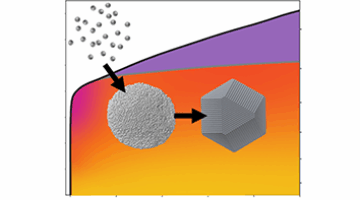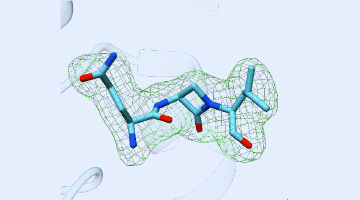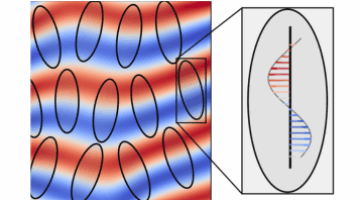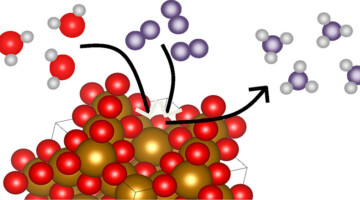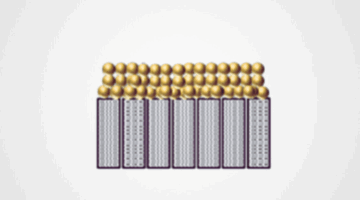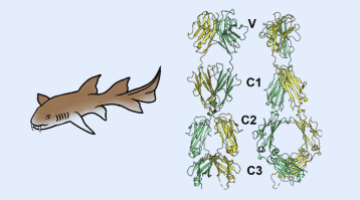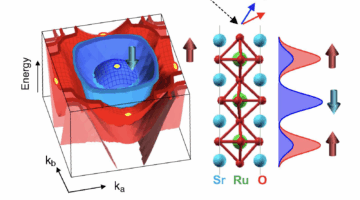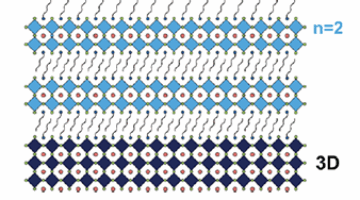Researchers used the Advanced Light Source to clarify how an unusual intermediate state accelerates the transformation of nanocrystals into a superlattice during a two-step process with fewer defects than a one-step process. Read more »![]()
Science Highlights
X-Rays Shed Light on Possible New Treatments for TB
Using ALS beamlines, a new study revealed how CMX410 inhibits Pks13, a cell wall enzyme in Mycobacterium tuberculosis, the bacterium responsible for tuberculosis. CMX410 is effective against drug-sensitive and drug-resistant strains of the bacterium and has been proven safe in multiple animal models of infection. Read more »![]()
Nematic Magnetic Helices Fluctuate at Different Tempos
During a series of experiments at the ALS, researchers identified helical magnetic spins that fluctuate at different time scales during a phase transition as a function of temperature in a nematic iron germanium thin film. The results provide a framework for characterizing exotic phases, which may have interesting optical and transport properties for microelectronics and spintronics. Read more »![]()
![]()
From Magnetite to Ammonia, A New Line of Production
Ammonia is a critical ingredient in many important industrial and agricultural applications. The Haber–Bosch process is the primary process for large-scale ammonia production. A new study uses an experimental–theoretical approach to uncover how interfacial chemistry at the magnetite–water interface drives ammonia synthesis under ambient temperature and pressure. Read more »![]()
![]()
Characterizing Membrane Fouling with Operando Experiments
Membrane filtration offers a cost-effective, energy-efficient approach to purify and desalinate water, but fouling limits the performance of these devices. A new study explored the new experimental design that allows one to study the dynamic fouling process in real time to improve the field’s understanding of how materials deposit, accumulate, and/or crystallize on the membrane’s surface. Read more »![]()
![]()
Sharks Shed Light on Origins of Adaptive Immune System
A team of researchers identified the three-dimensional structure of a protein expressed by a gene of a modern nurse shark that is proposed to be a close homologue to a gene that, more than 500 million years ago, gave rise to the adaptive immune system shared by all vertebrates. By understanding the emergence and evolution of the immune system, researchers may advance work in immunology, genetics, and biotechnology.
Read more »![]()
![]()
Pinpointing Magnetic Mysteries and Mechanisms in a Layered Perovskite
The strontium ruthenate family has a perovskite-like structure that can assemble into different configurations, offering an ideal way to study how the physics change as the material goes from 3D to 2D. In this study, researchers revealed how electrons with different spins behave in distinct layers of a three-layer magnetic material. The results deepen the field’s understanding of how magnetism emerges in layered materials, an important concept for future magnetic technologies and quantum electronic devices. Read more »![]()
![]()
Stable 2D Interlayer Prolongs Perovskite Devices
Layered 2D/3D perovskite bilayer heterostructures have the potential to boost the performance and durability of many types of electronic and photonic devices, but maintaining this performance depends on the stability of the cell’s 2D interlayer. In this study, researchers optimized time-resolved, spontaneous thin-film deposition of 2D perovskites using a mixed solvent approach to produce phase pure, stable thin films with high crystallinity. Read more »![]()
![]()
Multimetallic Systems Convey Cost-Effective Hydrogen Storage
A bimetallic material (Pd-Ni) produces hydrogen-active nanopockets that improve the efficiency and lower the cost of hydrogen storage systems. Mechanistic understanding of a Pd-Ni bimetallic system paves the way to design cost-effective hydrogen storage, opening new opportunities to develop reliable energy technologies necessary to advance the energy industry. Read more »![]()
![]()
A New Twist for Superconductivity in Bilayer Graphene
In a study of twisted bilayer graphene (TBG) systems, researchers found intriguing spectroscopic features in a superconducting “magic-angle” TBG—features that are absent in non-superconducting TBG. The results provide crucial information on superconductivity in magic-angle TBG for next-gen electronics and advanced energy technologies. Read more »![]()
![]()
- 1
- 2
- 3
- …
- 27
- Next Page »
